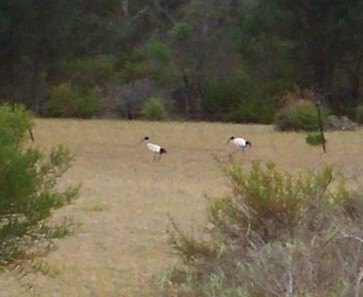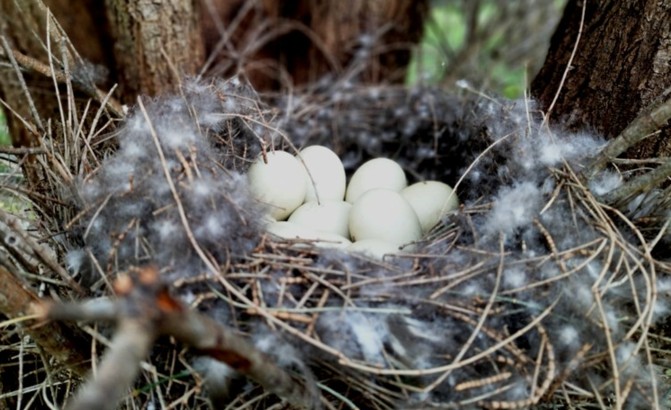WESTERN COVE WILDLIFE: BIRDS
Some more birds seen at Western Cove
CORMORANT
IBIS

PEACOCK
EGGS

Some more birds seen at Western Cove
CORMORANT
| The left photo shows a cormorant,
two pigeons and two oyster catchers. When I tried to approach closer
the cormorant stepped into the water, floated several metres, then
dived. It stayed under water half a minute
and reappeared 20 metres away. Cormorants have short legs, webbed feet, long neck, slender hooked bill, and mainly black plumage. The World Atlas of Birds says: "Nests, made of twigs and/or seaweed, are build on islands, mainland cliffs and sometimes in trees." This cormorant, however, spent the night on the beach where the beach meets the forest. I noticed it while taking a walk on the beach by moonlight. Its bill and head were tucked into its feathers but It looked up as I came close and made no attempt to get away. This was a vulnerable way for a cormorant to spend the night. I saw the cormorant once more the next day, dead at the water's edge. |
IBIS

| These birds were photographed in October and apparently
lived at this spot at Western Cove for several months during their
breeding season. When I checked
again in March they were gone. The species appears to be the Australian
White Ibis
- Genus: Threskiornis Species: T. aethiopica or T. molucca. Three species of Ibis live on KI of which this is the most common one. The White Ibis is a wading bird with bare black head and neck, long downcurved bill, white body plumage, and black legs. It lives mainly in grasslands near marshes and feeds on frogs, fish and insects. Breeding in southern Australia is August to November. The nest is a shallow circle of grass, sticks and reeds located near trees often near a river, swamp or lake. |
PEACOCK
| Peacocks and peahens belong to the Phasianidae or pheasant
family which include the quail, partridge, and peafowl. A family of peacocks/peahens live at Western Cove. They are mostly green in color and their loud calls are regularly heard after sunset. I see them often and sometimes five or more walk in single file past my house. I lack a photo since they run away if they see humans as close as a hundred metres. If startled by encountering a human very close they fly rather than run. The bodies of the adults are about 70 centimetres long which makes them the second largest bird at Western Cove after the pelican. Some years ago the peacocks had the irksome habit of roosting on my roof every night at 2 or 3 a.m. until dawn. The noise would awake me and their manure would wash into the rainwater tank when it rained. I reacted by quietly sneaking outside and banging a plastic rake against the roof guttering. The result was a noisy panic as the peacocks rapidly flew away. After a number of repetitions on successive nights they stayed off my roof permanently. |
EGGS

| A
clutch of eggs is the number of eggs a bird lays during one nesting
period. An ostrich may lay more than 50 eggs; a Wandering Albatross
breeds on alternate years and lays only one. I discovered the pictured nest on October 11 (2022) when going for a stroll near some sheoaks and experienced a sudden loud flutter as a bird flew past my face. It happened too fast for me to see the bird. If anyone can identify from the eggs or nest what bird it was, please let me know. The nest was about 1.4 metres above ground, 30 centimetres diameter, and the eggs numbered at least ten. The bird might have been a duck because ducks are said to lay from 8 to 18 eggs although this varies with species (the Australian wood duck lays 8-12 eggs). I'm also not sure whether ducks build nests in trees. https://en.wikipedia.org/wiki/List_of_birds_of_Kangaroo_Island,_South_Australia https://en.wikipedia.org/wiki/Bird_egg https://petkeep.com/how-many-eggs-do-ducks-lay/ https://www.allaboutbirds.org/guide/search |